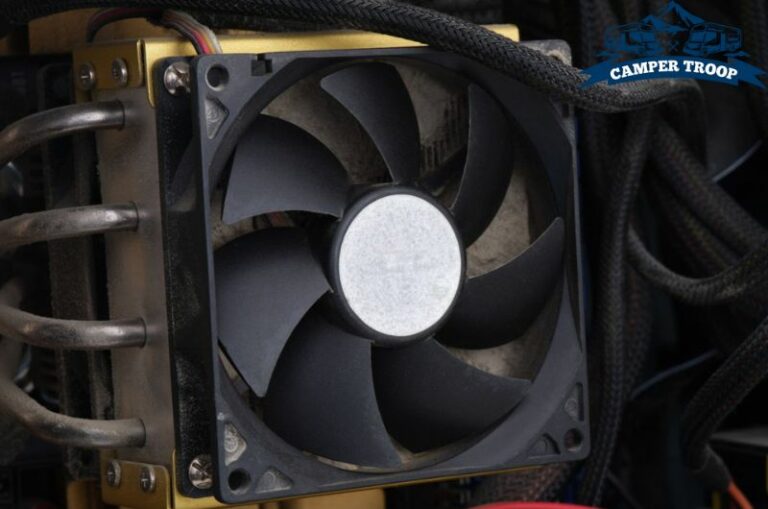How to Replace Rubber Seal on a Propane Tank? (Detailed Guide)
Propane tanks are essential for outdoor cooking and recreational activities, but the rubber seals that keep gas from leaking can wear down over time. So, if you’re an RV-er or camper, you may have to replace your propane tank’s seal more often than the average person.
Luckily, regardless of your skill level, it should be fairly easy if you’re willing to learn how to replace the rubber seals on a propane tank. A successful installation depends on finding the proper seal, applying the gasket sealant, and correctly seating the replacement seal.
Let’s walk you through the steps I followed to replace the rubber seal on my propane tank without a hitch.

How to Find the Right Replacement Seal?
Propane tank O-ring or rubber seals are not universal and vary depending on the size of your tank. And it’s crucial to buy the right one.
To find out what you need, measure the inner diameter of your tank’s valve stem. Then, refer to a parts chart to determine the size and type of seal that fits your tank.
Or, you can simply take the old seal to the store with you. That way, you can ensure you get the right one without any guesswork.
Read Also: How Much Does It Cost to Replace an RV Front Cap?
Safety Tips Before You Proceed with Replacing the Rubber Seal
Propane tanks can leak and cause explosive mishaps around your campground or RV, making precautions essential. Here are some safety tips to keep in mind before replacing the old seal:
- Make sure the propane tanks are turned off.
- Ensure that you’re doing the replacement in a well-ventilated area.
- Avoid open flame or smoking materials when replacing the seal.
- Wear protective clothing and gloves, like eye protection and chemical-resistant gloves, throughout the process.
7 Steps to Replace the Rubber Seal on a Propane Tank Effectively
As an RV-er, I had to replace the rubber seal on my propane tank on more than one occasion. And here, I’ll share the method I found to be most effective.
Step 1: Gather Your Supplies
Before you begin, ensure you have all the supplies you need for a successful seal replacement. You’ll need the following:
- Propane tank
- New rubber seal (one that matches your propane tank’s size and brand)
- Gasket sealant (I prefer Loctite 518 Gasket Eliminator)
- A pair of slip-joint pliers
- A flathead screwdriver
- An adjustable wrench
- A metal pick
Step 2: Remove the Old Seal
Start by using a flathead screwdriver to loosen the clip that holds the gas hose to the tank. Then, completely remove the old seal. Sometimes, it may get stuck and not come off easily. Whenever that’s the case, I use a pair of slip-joint pliers to remove it gently.
Read Also: Do I Need A Surge Protector For My RV? (Explained)
Step 3: Clean the Threads
Next, use a soft bristle brush to clean the valve’s threads. This will allow for a secure attachment when you install your new seal. I’ve seen some people use a wire brush, but I wouldn’t recommend that since the wire bristles may smudge off the threads.
Step 4: Apply the Gasket Sealant on the Threads
Now, apply a thin sealant layer on the valve’s threads and allow it to sit well for a few minutes. As I mentioned earlier, Loctite 518 Gasket Eliminator is the sealant I use because it’s strong, reliable, and easy to apply. Besides, it’s designed to resist heat, oil, and other contaminants.
Step 5: Install the New Seal
Once the sealant is dry, it’s time to install the new seal. Make sure you double-check that the size of your new seal matches the propane tank before installation.
Then, gently insert the seal and twist it into the valve. I like to use a brass pick to wedge the seal into the valve to ensure it’s properly seated.
Step 6: Secure the Seal with a Wrench
Now, you’ll need an adjustable wrench to tighten the seal into place. This is a crucial step, as it helps ensure that no gas will leak from your propane tank.
Step 7: Reattach the Gas Hose and Test Your Work
Finally, you can reattach the gas hose to your propane tank. Make sure you firmly attach the clip to keep it in place.
Once your hose is securely attached, you can test the seal for any potential leaks. To do this, pressurize the tank and check if any gas seeps out around the seal. If there are no signs of leakage, you can enjoy the benefits of your newly installed seal without worries.
Read Also: Why RV Antenna Won’t Crank Up: Reasons & Solutions!
How to Tell if You Need a New Rubber Seal on Your Propane Tank
The most telling sign that the propane seal needs to be replaced is if your propane tank is leaking gas. However, it could be too late by then. So, know when to replace your seal before it leaks and causes an explosion by observing these:
- You can sense a rotten egg-like propane smell from the tank (even when there’s no visible leak).
- You can hear a low, hissing noise of propane leaking from the tank.
- The seal is cracked, corroded, or damaged in any way.
- There’s noticeable wear and tear around the seal.
- The connector that attaches the tank to the stove gets loose more often than usual.
Read Also: RV Kitchen Faucet Spout Came Off: 8 Must-Try Steps To Fix It!
Frequently Asked Questions
Below, I have compiled answers to some of the most commonly asked questions about propane seals.
How often should I check my propane tank’s rubber seal?
You should inspect your rubber seal every so often to ensure it’s in good condition. A good time frame would be once a year before the camping season starts.
Can I use any rubber seal for my propane tank?
No, you must ensure the seal you purchase is the proper size and shape for your propane tank. Otherwise, it may not fit properly or prevent gas from leaking.
Is it dangerous to replace my own seal?
It can be done incorrectly. Ensure you follow all safety precautions when replacing your seal, including turning off the gas, wearing protective gear, and using the right tools.
Does a propane tank work without the o-ring seal?
No, the o-ring seal helps prevent gas leaks and ensures the proper functioning of the propane tank. Without it, your tank won’t be able to hold the gas it needs to supply your camping appliances.
Conclusion
Propane tanks are an essential part of camping and require regular maintenance. And when it comes to maintenance, a rubber seal replacement is critical to safety and proper functioning.
As you can see, replacing a rubber seal on your propane tank is easier than it may seem. If you read the directions carefully and follow them closely, you shouldn’t have trouble replacing your tank’s seal at all.
On a final note, if you’re ever unsure of your abilities or are having trouble replacing the seal, feel free to reach out to a professional. They’ll be able to help you get your propane tank working safely and efficiently.
Read Also: How to Fix an RV Faucet That Won’t Turn Off? (6 Easy Steps)

Zayan is an accomplished author and a go-to expert for all things RV and camper-related. With a passion for adventure and a knack for problem-solving, he has spent years exploring the open road and fine-tuning his knowledge of recreational vehicles.
Zayan’s writing is a testament to his expertise, offering readers practical solutions to common RV dilemmas. Whether it’s troubleshooting mechanical issues, optimizing space, or planning the perfect road trip, Zayan’s insightful advice and engaging storytelling make him an invaluable resource for both seasoned travelers and newcomers to the world of RVing.






